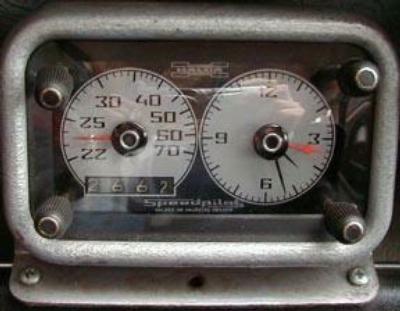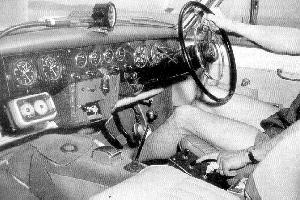The MGA With An Attitude
Rally Computer, HALDA SPEEDPILOT - COMP-203A
A Most Accurate Average Speed Computer
From AUTOSPORT - March 9 1956.
The Halda Speed-Pilot

A Most Accurate Average Speed Computer Thoroughly Proved in Rallies.
Simple and compact the Swedish made Halda Speed Pilot can be fitted to any make of vehicle. It was used successfully on the Monte Carlo Rally by Maus Galsonides (Standard Vanguard), and the Sunbeam team.
 Some time in the 1890's, the Swedish engineering firm of Haldex A.B. began supplying taximeters for London's horse-cabs. Subsequently, Halda taximeters were fitted to the new motor cabs and now the latest models are supplied in thousands to taxis and hire-cars all over the world.
Some time in the 1890's, the Swedish engineering firm of Haldex A.B. began supplying taximeters for London's horse-cabs. Subsequently, Halda taximeters were fitted to the new motor cabs and now the latest models are supplied in thousands to taxis and hire-cars all over the world.
As taximeters are essentially computing devices coupled to the speedometer drive, it would seem that the specialized "know-how" acquired in their development could well be applied to the production of a successful average speed computer. Halda has done just that, and the Speed-Pilot is the result.
We have had a Speed-Pilot on test in a staff car for some weeks; as a result of this trial we feel confident in saying that it is a considerable advance upon anything of the kind previously marketed, as regards usefulness, compactness, mechanical simplicity (and hence reliability), simplicity of operation and price.
The complete unit is quite small (about 6 x 4 in. overall). There are four control knobs and two dials. The left-hand dial is set at the start of the journey to the average speed required. The right-hand dial is an eight day clock, but incorporates a third hand, a red one with a distinguishing "Blob" on it, which is set immediately beneath the minute hand of the clock at the time of departure. This "Pilot" is coupled (indirectly!) to the speedometer drive and this moves at a rate proportional to the road speed. Thus, if for example one is required to average 30 m.p.h., the left-hand dial is set accordingly, and if one maintains precisely 30 m.p.h. the Pilot hand will remain co-incident with the minute hand of the clock. If one travels at more than 30, the Pilot will gain on the clock, and if slower will lag behind. Thus at any point on the journey, regardless of stops or delays, one can see at a glance exactly how many minutes one is ahead of or behind schedule. The speed dial can be set to any average from 22-75 m.p.h. and a variable escapement mechanism makes the necessary adjustment; that could be simpler? In addition, the clock can be used as a clock and there is also a trip mileage recorder, calibrated in tenths and hundredths.
Installation is easy. A T-drive is coupled between the speedometer and its cable, and a further short cable brings the drive to the Speed Pilot, which can be fitted flush in a hole cut in the dash, or hung on its own bracket in any suitable place. An internal bulb gives effective edge illumination to the dials. Once installed, the instrument is adjusted to suit the particular car, entirely by means of a calibrating screw. The very comprehensive instruction sheet gives precise details of how many turns are required, and once set, final adjustment may be made on the road to a very high degree of accuracy, irrespective of the accuracy of the car's odometer. Even a change of tyre size can be allowed for, and it is a simple matter to switch the device from one car to another. It is available marked either in m.p.h. or k.p.h.
Being entirely mechanical, there are no electrical or electronic devices to give trouble and as can be seen, it is no bulky or unsightly addition to a car's equipment. Inquiries (in England) about the Speed-Pilot should be directed to Halda Ltd., Brandon Road, York Way, London, N. 7. By the way, with each kit is supplied a disc calculator (time/speed/distance) plus (and this beats all the window pennants) a red Scotchlite label reading "Speedpilot"!
|